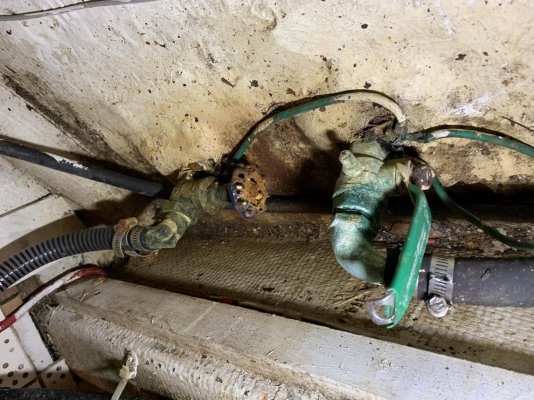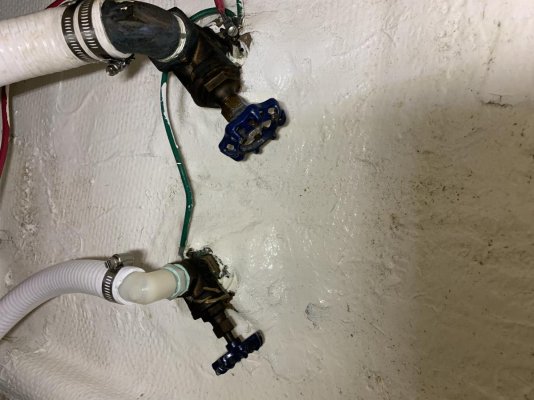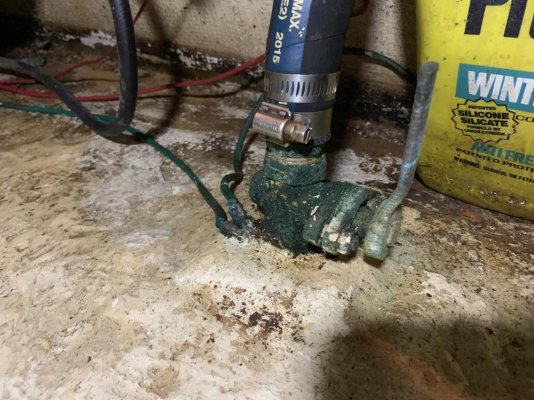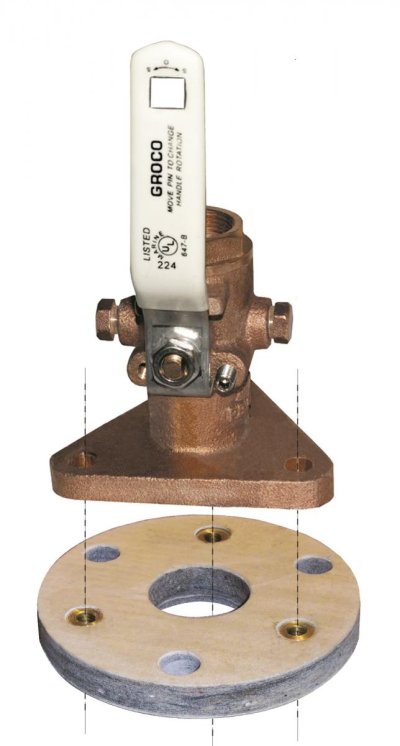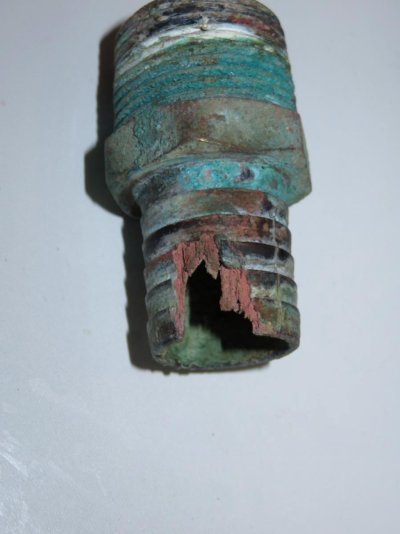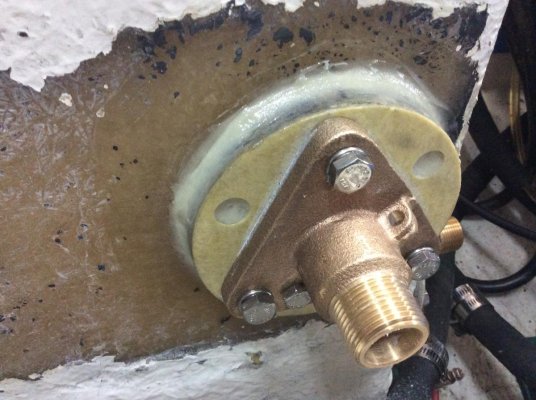Hey, is glassing over a seacock flange normal? I feel like a PO did it to strengthen it...but now it’s my mess to deal with. I would like to cut away the glass to see what I’m dealing with, but worried it may be the only thing holding the seacocks in place. Any suggestions?
You are using an out of date browser. It may not display this or other websites correctly.
You should upgrade or use an alternative browser.
You should upgrade or use an alternative browser.
Fiberglassing over seacock flange
- Thread starter Wanna-b
- Start date
The friendliest place on the web for anyone who enjoys boating.
If you have answers, please help by responding to the unanswered posts.
If you have answers, please help by responding to the unanswered posts.
Comodave
Moderator Emeritus
- Joined
- Jul 2, 2015
- Messages
- 22,445
- Location
- Au Gres, MI
- Vessel Name
- Black Dog
- Vessel Make
- Formula 41PC
That is a bit strange. I would be more comfortable if I could see the fittings. I know that if they were S/S you definitely would not want them like that due to crevice corrosion. I am not sure if bronze suffers from something like that or not. But it would be nice to be able to see how they are secured.
AKDoug
Guru
Newer standards call for a backing plate to be glassed or epoxied to the hull with the seacock mounted to it or through it. That might have been acceptable before the new standards went into practice.
When I bought my boat, I had Zimmerman's yard do one through hull to the new standards, since it was leaking anyway. It is G10 epoxied to the hull, drilled and tapped for the seacock mounting flange. My plan is to slowly finish all of them to the new standard as it is convenient for me.
When I bought my boat, I had Zimmerman's yard do one through hull to the new standards, since it was leaking anyway. It is G10 epoxied to the hull, drilled and tapped for the seacock mounting flange. My plan is to slowly finish all of them to the new standard as it is convenient for me.
motion30
Guru
- Joined
- Jan 14, 2010
- Messages
- 1,216
My marine trader was like that
Dougcole
Guru
Glassing over the flange isn't a great idea, but then neither are gate valves....
That's what i thought too. It looks to me that all of those seacocks need to be replaced. If you are going to replace them, no point in not doing it the right way.
Even ball valves, though not ideal, would be better than gate valves.
Maerin
Guru
Is it normal? Normal can be a lot of things.
It's not a method you'll find mentioned in the ABYC standards, which are pretty complete regarding installation of thru-hulls.
There's not much about those configurations that's redeeming. From the gate valves to the cover-up with glass, they border on scary. I'd have those on the "to-do" upgrade list at next haul.
There's a great site with very specific and excellent "best practice" instruction on how to properly install a thru hull. HERE
A clean, proper installation is within the reach of a DIY with mechanical skills and some experience.
It's not a method you'll find mentioned in the ABYC standards, which are pretty complete regarding installation of thru-hulls.
There's not much about those configurations that's redeeming. From the gate valves to the cover-up with glass, they border on scary. I'd have those on the "to-do" upgrade list at next haul.
There's a great site with very specific and excellent "best practice" instruction on how to properly install a thru hull. HERE
A clean, proper installation is within the reach of a DIY with mechanical skills and some experience.
HopCar
Guru
- Joined
- Aug 20, 2011
- Messages
- 5,363
- Vessel Name
- Possum
- Vessel Make
- Ellis 28
Those photos scare me. I bet those gate valves won’t even close. The one ball valve looks like a cheap hardware store valve. The one seacock looks like a tapered cone valve that hasn’t been serviced in years. Next haul out I think you should replace all of those valves with real flanged seacocks.
My choice would be a Groco or Apollo seacock mounded on one of Groco’s backing blocks.
My choice would be a Groco or Apollo seacock mounded on one of Groco’s backing blocks.
Attachments
Guessing those gate valves are above the waterline. Not an emergency repair but I would replace them. The one seacock that appears to be main raw water intake looks very corroded. At a minimum it should be disassembled and cleaned. (Out of the water)
I would take a dremel and start grinding through a corner to see what's underneath. If there is a wood backing plate in good condition, just fill in with resin. If nothing, replace.
I would take a dremel and start grinding through a corner to see what's underneath. If there is a wood backing plate in good condition, just fill in with resin. If nothing, replace.
I’d plan on replacing all the thru hulls, seacocks, clamps and bonding wires (out of the water). It looks like you have reasonable access but it needs to be done.
The two gate valves should be done ASAP. They’re probably brass and shouldn’t be used on a boat below the water line or where sea water is involved. Brass suffers from dezincification. The zinc sacrificially corrodes leaving behind a weak valve. We had a gate valve on a 1966 ChrisCraft and the valve stem disintegrated.
Here’s a nipple that was brass that was suppose to be bronze that suffered from dezincification. This was below the water line and fortunately I found it before it completely failed.
The two gate valves should be done ASAP. They’re probably brass and shouldn’t be used on a boat below the water line or where sea water is involved. Brass suffers from dezincification. The zinc sacrificially corrodes leaving behind a weak valve. We had a gate valve on a 1966 ChrisCraft and the valve stem disintegrated.
Here’s a nipple that was brass that was suppose to be bronze that suffered from dezincification. This was below the water line and fortunately I found it before it completely failed.
Attachments
mvweebles
Guru
- Joined
- Mar 21, 2019
- Messages
- 7,780
- Location
- United States
- Vessel Name
- Weebles
- Vessel Make
- 1970 Willard 36 Trawler
Bluntly, these valves need to go ASAP. There is no way to tell when they will fail - one of the Steve D articles linked below shows de-zinc-ification similar to the wasted barbed nipple pic in a previous post on this thread. It cannot be inspected unless disassembled. In the words of Dirty Harry "You have to ask yourself, do I feel lucky?"
HopCar's post shows the best seacock arrangement (versus a straight mushroom post with inline valve - Steve D goes into this further). Maerin's post includes a link to how to install. If you need more convincing, here's an article from Mr. Boat Wiki himself (Steve D)
Finally, another article from Steve D on hose selection, but also has decent pictures on using a manifold to consolidate casual intakes into a single thru-hull/strainer.
Bottom line - it's time to replace.
HopCar's post shows the best seacock arrangement (versus a straight mushroom post with inline valve - Steve D goes into this further). Maerin's post includes a link to how to install. If you need more convincing, here's an article from Mr. Boat Wiki himself (Steve D)
Finally, another article from Steve D on hose selection, but also has decent pictures on using a manifold to consolidate casual intakes into a single thru-hull/strainer.
Bottom line - it's time to replace.
FF
Guru
- Joined
- Oct 12, 2007
- Messages
- 22,552
"My choice would be a Groco or Apollo seacock mounded on one of Groco’s backing blocks."
AND thru bolted .
https://shop.marshfasteners.com/SILICON-BRONZE-OVAL-STRUT-BOLTS-SLOTTED/products/588/
AND thru bolted .
https://shop.marshfasteners.com/SILICON-BRONZE-OVAL-STRUT-BOLTS-SLOTTED/products/588/
angus99
Guru
"My choice would be a Groco or Apollo seacock mounded on one of Groco’s backing blocks."
AND thru bolted .
https://shop.marshfasteners.com/SILICON-BRONZE-OVAL-STRUT-BOLTS-SLOTTED/products/588/
I respectfully disagree. The Groco backing plates, if properly bonded with epoxy or fiberglassed to the hull, including fillets around the circumference, are considered by the experts I consulted to be the equal of through-bolting. Also, if you’re using the Groco through hull and flange (see HopCar’s post above), the NPT threads match each other (unlike most older installations which try to force-fit both straight and tapered threads) and they take a much deeper bite. This deeper connection adds considerable strength to the overall installation.
Attachments
RT Firefly
Enigma
Greetings,
I don't know if this has been mentioned but the glass over is probably factory direct.
I don't know if this has been mentioned but the glass over is probably factory direct.
Thanks. Someone called it correctly, I can’t even close the raw water seacock. I’m replacing every through hole ASAP. Anyone know of a good yard where I can do the work myself in the Seattle area?
Canal Boatyard in Ballard is a good diy.
Home
mvweebles
Guru
- Joined
- Mar 21, 2019
- Messages
- 7,780
- Location
- United States
- Vessel Name
- Weebles
- Vessel Make
- 1970 Willard 36 Trawler
I respectfully disagree. The Groco backing plates, if properly bonded with epoxy or fiberglassed to the hull, including fillets around the circumference, are considered by the experts I consulted to be the equal of through-bolting.
Agree with Angus99's comments. I am re-locating through hulls as part of my refit. I really appreciated the previous links to how-to as they solved the question on whether to thru-bolt. I really didn't want extra penetrations. In the end, what got me over the line was the threaded mushroom thru-hull provides significant structure and strength. No need to thru-bolt. The Groco backing plates are fine. At least that's the decision I went with.
Peter
HopCar
Guru
- Joined
- Aug 20, 2011
- Messages
- 5,363
- Vessel Name
- Possum
- Vessel Make
- Ellis 28
Peter, When you bed the backing plates in epoxy, put bolts in the threaded holes to prevent the epoxy from getting into the threads. Once the epoxy hardens just back the bolts out and you’ve got nice clean threads.
mvweebles
Guru
- Joined
- Mar 21, 2019
- Messages
- 7,780
- Location
- United States
- Vessel Name
- Weebles
- Vessel Make
- 1970 Willard 36 Trawler
Thanks HopCar. I'm putting my order to gather in next day or so. I'm fairly new to TF. Joined a few months ago to get info like this. I really appreciate professionals like yourself contributing. I look forward to doing business with you! I'd never heard of you guys before - Peggy Hall gave y'all a thumbs up. Good enough for me.Peter, When you bed the backing plates in epoxy, put bolts in the threaded holes to prevent the epoxy from getting into the threads. Once the epoxy hardens just back the bolts out and you’ve got nice clean threads.
Voyager3
Veteran Member
I had only 1 valve that was glassed over and not done very well either. I chiseled the fiberglass away and removed the thru hull. It was not in a good area and would never be able to be closed in an emergency. Some fiberglass work may be required after you remove it. I am replacing 4 on 1 side that are below the water line and no valves on them?? The Groco valves and backing plates are replacing the existing.
Does anyone know which is better, using SS ball valves or what ever the other ball is made of?? Planning on the SS unless someone knows better.
Does anyone know which is better, using SS ball valves or what ever the other ball is made of?? Planning on the SS unless someone knows better.
mvweebles
Guru
- Joined
- Mar 21, 2019
- Messages
- 7,780
- Location
- United States
- Vessel Name
- Weebles
- Vessel Make
- 1970 Willard 36 Trawler
Does anyone know which is better, using SS ball valves or what ever the other ball is made of?? Planning on the SS unless someone knows better.
This is a really good question. I am a huge fan of Groco and I chose their bronze products as much as possible (they also have limited SS products too, but I have never used their SS). But I really don't know if it makes much of a difference - zinc is first in line to take the slack. Most prop shafts are SS, so obviously they do just fine. I'd be interested too in substantive responses.
Peter
HopCar
Guru
- Joined
- Aug 20, 2011
- Messages
- 5,363
- Vessel Name
- Possum
- Vessel Make
- Ellis 28
Thanks HopCar. I'm putting my order to gather in next day or so. I'm fairly new to TF. Joined a few months ago to get info like this. I really appreciate professionals like yourself contributing. I look forward to doing business with you! I'd never heard of you guys before - Peggy Hall gave y'all a thumbs up. Good enough for me.
I no longer own the business. I retired and sold it about two years ago. It is really nice that Peggy still thinks highly of me. Have you got her book yet?
AKDoug
Guru
SS is subject to crevice corrosion in an anaerobic environment, and I would think being in a valve body would be anaerobic... I have never heard of a down side to bronze unless it's not properly grounded or has no sacrificial anode. Bronze is also self lubricating (to a point), I would opt for bronze over stainless. JMO, but if I were you, I would research that a little.
HopCar
Guru
- Joined
- Aug 20, 2011
- Messages
- 5,363
- Vessel Name
- Possum
- Vessel Make
- Ellis 28
I had only 1 valve that was glassed over and not done very well either. I chiseled the fiberglass away and removed the thru hull. It was not in a good area and would never be able to be closed in an emergency. Some fiberglass work may be required after you remove it. I am replacing 4 on 1 side that are below the water line and no valves on them?? The Groco valves and backing plates are replacing the existing.
Does anyone know which is better, using SS ball valves or what ever the other ball is made of?? Planning on the SS unless someone knows better.
Groco makes two flanged seacocks, the BV series and the FBV. The BV is made in America and the FBV is imported.
The BV is much heavier and has a stainless ball and stem. It’s not cheap.
The FBV is lighter and has a chrome plated brass ball. It is less expensive. I would prefer the BV but I wouldn’t worry if I had to use the FBV. It would probably outlast me.
Another option is to use Groco’s Flanged Adapter and a good ball valve. That way if the valve goes bad, it’s easy to replace. Price wise I think this falls between the BV and FBV.
- Joined
- Nov 8, 2012
- Messages
- 2,325
- Location
- Port Orchard, WA
- Vessel Name
- Sandpiper
- Vessel Make
- Bluewater 40 Pilothouse Trawler
Peter, When you bed the backing plates in epoxy, put bolts in the threaded holes to prevent the epoxy from getting into the threads. Once the epoxy hardens just back the bolts out and you’ve got nice clean threads.
Coat the bolt with vaseline or grease before inserting into the holes. Otherwise, the epoxy may wick up the thread.
- Joined
- Nov 8, 2012
- Messages
- 2,325
- Location
- Port Orchard, WA
- Vessel Name
- Sandpiper
- Vessel Make
- Bluewater 40 Pilothouse Trawler
I respectfully disagree. The Groco backing plates, if properly bonded with epoxy or fiberglassed to the hull, including fillets around the circumference, are considered by the experts I consulted to be the equal of through-bolting. Also, if you’re using the Groco through hull and flange (see HopCar’s post above), the NPT threads match each other (unlike most older installations which try to force-fit both straight and tapered threads) and they take a much deeper bite. This deeper connection adds considerable strength to the overall installation.
I agree.
I've never through bolted seacocks. With the hull and bonded backing plate sandwiched between a straight thread flanged seacock and a straight thread mushroom thru-hull trimmed to the proper length, it is unnecessary to through bolt. I do install one screw through a hole to prevent the seacock from unscrewing if using a wood backing plate. And a bolt if using Groco's backing plate.
FF
Guru
- Joined
- Oct 12, 2007
- Messages
- 22,552
It would seem the photo sea cock (# 14) is properly thru bolted or the GRP backing plate is threaded or somehow the bolt is finding its mounting nut and the excess bolt length is not poking a hole in the bottom.
A sea cock may need to take the weight of a flying tool box and is expected to be functional if a thru hull is removed for inspection and re installed.
It would seem the mount bolts are SS another risk in seawater.
A sea cock may need to take the weight of a flying tool box and is expected to be functional if a thru hull is removed for inspection and re installed.
It would seem the mount bolts are SS another risk in seawater.
Last edited:
rslifkin
Guru
- Joined
- Aug 20, 2019
- Messages
- 8,005
- Location
- Rochester, NY
- Vessel Name
- Hour Glass
- Vessel Make
- Chris Craft 381 Catalina
It would seem the photo sea cock (# 14) is properly thru bolted or the GRP backing plate is threaded or somehow the bolt is finding its mounting nut and the excess bolt length is not poking a hole in the bottom
From what's been described (and what I know about the Groco backing plates), the setup in post 14 is a threaded backing plate. So the plate is epoxied to the hull and then the flange is bolted to the plate. Done correctly, it's just about as strong as through bolting (certainly strong enough) and without the extra holes in the hull.
angus99
Guru
It would seem the photo sea cock (# 14) is properly thru bolted or the GRP backing plate is threaded or somehow the bolt is finding its mounting nut and the excess bolt length is not poking a hole in the bottom.
A sea cock may need to take the weight of a flying tool box and is expected to be functional if a thru hull is removed for inspection and re installed.
It would seem the mount bolts are SS another risk in seawater.
Fred, it seems you have a lot of concerns about these assemblies. So let’s address them one-by-one.
The three bolts you mention only go through the backing plate—not the hull—and attach to captive nuts in the backing plates. They are sized to not protrude beneath the backing plate and they are not in contact with seawater. The backing plates are a composite material that doesn’t absorb water and they are epoxied to the hull or, in my photo, to the sea chest. The mushroom, using matching threads, engages the flange almost 1 inch deep, adding considerable strength—vastly more than the two or three threads holding Seacocks to mushrooms in many older boats. Both the mushroom and the flanged adapter are embedded in 5200, but the valve is easily removed for inspection and replacement.
I know these are not old school and you have strong opinions about them, but short of throwing a tool box at them, I believe the engineers at Groco and Rod Collins do have a clue about what makes for a strong through hull assembly. Rod has subjected a flanged base/valve assembly bolted only to a 1/2” GPO backing plate to 1000 lbs of pressure.
https://marinehowto.com/seacock-backing-plates/
Now Groco uses a different material for their backing plates but their tech support folks say the flanged adapter valve assembly—using a fully engaged mushroom—meets or exceeds the ABYC shear test.
So can we put to rest the notion that these are somehow inferior installations?
Last edited:
Similar threads
- Replies
- 23
- Views
- 1K

